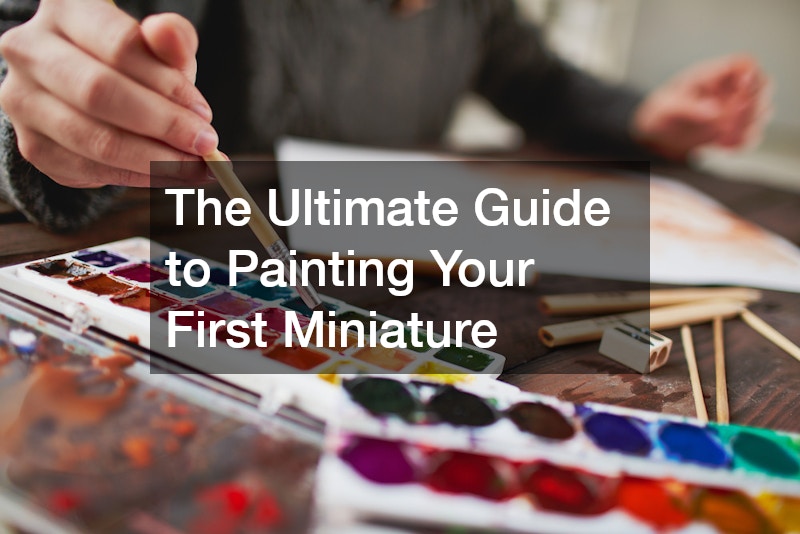
Welcome to the exciting world of miniature painting! Whether you’re interested in tabletop gaming, model building, or simply looking for a new creative outlet, this guide will set you on the path to mastering the art of painting miniatures. In this article, we’ll address the key questions beginners often have and provide step-by-step instructions to help you get started.
What materials do I need to start painting miniatures?
Essential Tools and Supplies
Before you begin painting, you’ll need to gather some essential tools, including quality brushes, paints, and primer. Brushes are crucial for detail, and choosing a variety will give you the flexibility needed for different techniques and effects. You’ll also require a good primer, which helps paint adhere better to the miniature and can enhance its final appearance.
Quality brushes have various shapes and sizes, each suited to a specific part of the miniature or a particular technique. For paints, you will need a selection that offers a balance between color variety and pigment concentration to ensure your miniatures look vibrant and detailed. Primers usually come in aerosol or brush-on forms, each with distinct advantages depending on your comfort level and workspace.
You can purchase these materials at specialty hobby stores, many of which offer expert advice for novices and enthusiasts alike. Alternatively, online model shops provide a convenient way to explore a vast range of products, often accompanied by reviews and tutorials. Many online platforms also host communities where beginners can seek guidance from experienced miniature painters.
Choosing the Right Paints
Different types of paints can have varied effects on your miniature painting. Acrylics are favored by many as they dry quickly, are easy to clean with water, and have vibrant pigmentation. Enamels, on the other hand, have a glossy finish and are often more durable, though they require solvents for cleaning.
Oil paints offer extended drying times, ideal for blending but potentially difficult for beginners who want to see quick results. While acrylics are the go-to for most hobbyists due to their flexibility and wide availability, some projects may benefit from experimenting with different types. Popular brands such as Citadel, Vallejo, and Army Painter offer excellent ranges that cater to various preferences and needs.
Ultimately, the choice of paint depends on your personal goals and the type of projects you aim to undertake. Acrylics might be the best option if you’re looking for versatility and ease of use. However, don’t shy away from trying enamels or oils once you gain more confidence; they could add unique touches to your finished pieces.
Organizing Your Workspace
A well-organized workspace is key to a successful painting session. Allocating a dedicated area for your painting activities will help ensure comfort and efficiency. This space should be well-lit, ventilated, and have a stable surface for holding your miniatures and tools.
Utilize storage solutions such as drawers or containers to keep brushes, paints, and other supplies neatly arranged and accessible. Consider setting up a pegboard or shelf space for displaying completed works and organizing tools. Invest in a comfortable chair and proper lighting to reduce strain during prolonged painting sessions.
Organization not only saves time but also promotes a sense of order that can enhance creativity. A tidy workspace can inspire new ideas and increase productivity, allowing you to focus more on the artistic aspects of miniature painting. Regularly declutter and reassess the setup for the best results.
How do I master basic painting techniques?
Primer Application Basics
Applying primer correctly is a crucial step. The type of primer you choose can significantly affect the finish of your miniature, with options like spray-on primers offering quick and even coverage, while brush-on primers allow for more control. When priming, ensure the miniature is clean and free of any mold lines or debris, allowing the primer to adhere flawlessly.
To apply primer, hold the spray can or brush at an appropriate distance to achieve an even coat without obscuring fine details. Several light coats are often better than one thick coat to avoid pooling or obscuring intricate pieces of the model. Ensure you’re working in a well-ventilated area to avoid inhaling fumes, especially when using aerosol primers.
Priming serves as a foundation for the paint, helping you to achieve vibrant, long-lasting colors and consistent coverage. Different surfaces might require different primers, so experimenting with various types can help determine what works best for your specific needs. As you become more experienced, you’ll likely develop preferences for specific primers and application methods.
Understanding Brush Techniques
Brush control and technique are fundamental to painting. Layering, blending, and dry brushing are essential skills worth mastering early on. Layering involves building up color in thin coats, creating depth and richness without obscuring detail.
Blending allows for smooth transitions between colors, giving miniatures a more natural, realistic appearance. Dry brushing highlights edges and raised surfaces, adding texture and depth with minimal paint. Each of these techniques requires a steady hand and practice to perfect, but they can dramatically improve the quality of your finished miniatures.
It’s vital to understand the right type of brush for each technique; fine detail brushes for layering and small, firm brushes for dry brushing, and softer brushes for blending. Rotating between techniques within a single miniature brings out dynamic contrasts and textures, enhancing its appeal. As you gain more proficiency, experimenting with combinations will bring your personal style to life.
Finishing Touches: Highlighting and Detailing
Bringing your miniature to life requires attention to detail. Highlighting involves applying a lighter paint to elevated areas, simulating how light would naturally strike the figure. This technique adds dimension and can be achieved by following the form of your miniature with a light brush stroke.
Detailing provides the opportunity to showcase the small intricacies of your miniature, such as facial features, armor trim, or weaponry. Using a fine-tipped brush, you can emphasize these areas with precision and care. It can be especially satisfying to see details emerge with clarity, giving the miniature character and expression.
Sealing your miniature with a varnish can protect your handiwork from handling and environmental wear. Varnishes come in matte, satin, and glossy finishes, each adding a different effect to the completed model. Detailing and finishing touches turn your painted miniature into a display-worthy piece, highlighting your skills and creative vision.
Conclusion
Painting miniatures can be an immensely rewarding hobby that combines creativity with precision. By starting with the right materials and mastering basic techniques, you’re on your way to creating stunning miniatures. Remember, practice makes perfect, and the more you paint, the better you’ll become.
Enjoy the process and keep experimenting with new styles and methods. The journey of learning can be as gratifying as finishing a project, with each piece reflecting your evolving skillset and artistic expression. Engage with others in the community, share progress, and draw inspiration from fellow artists.
Happy painting! Dive into the world of miniatures and let your creativity shine through every brushstroke. As your collection grows, so will your craftsmanship, bringing detailed fantasy worlds to life, one miniature at a time.
“
.



